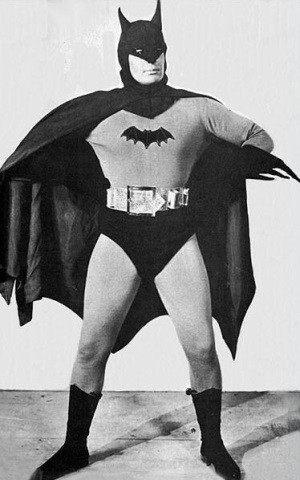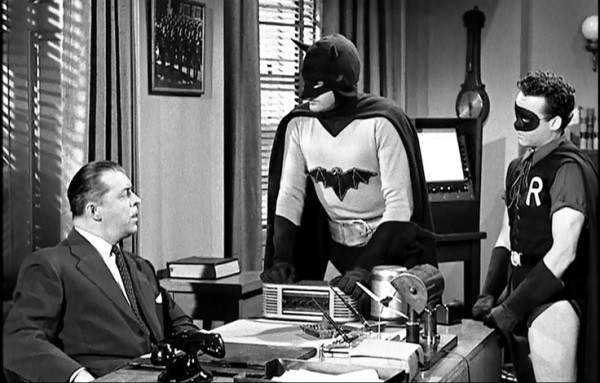 As we look back at the Batman character’s storied 75-plus year history, it is easy to lose sight of the fact that there was a time when he truly was a “new” character. And one of the biggest Batman events that took place when he was new was the release of his first celluloid appearance, the 1943 Columbia black-and-white 15-chapter serial simply entitled The Batman.
As we look back at the Batman character’s storied 75-plus year history, it is easy to lose sight of the fact that there was a time when he truly was a “new” character. And one of the biggest Batman events that took place when he was new was the release of his first celluloid appearance, the 1943 Columbia black-and-white 15-chapter serial simply entitled The Batman.
The Batman is an odd but fascinating mixture of Batman comic mythos, World War II propaganda and cheaply crafted cliffhanger clichés. Like most all serials of its time, each of serial’s chapters ended with a scene showing our hero facing seemingly inescapable mortal danger. Of course, Batman always managed to escape this danger in the next chapter, but the only way 1940’s moviegoers could know this for sure was to spend their money on a ticket for next week’s show.
Batman starred Lewis Wilson as Batman/Bruce Wayne, Douglas Croft as Robin/Dick Grayson, and J. Carrol Naish as the diabolical Japanese criminal mastermind Dr. Daka. Daka was Batman’s only villain – all 15 chapters of the serial revolved around Batman and Robin’s efforts to find him and bring him to justice. The villain had never appeared in Batman comic stories – he was created specifically for the serial in order to reflect the United States’ preoccupation with World War II.

Obviously, Batman was trying to bridge a rather uncomfortable gap between real-life threats to America and escapist entertainment. This combination might have seemed appropriate in the heat of the World War II years, but it certainly does not work for modern audiences – many of the anti-Japanese sentiments found in Batman’s scenes involving Daka come across now as bigoted and hysterical.
To make matters worse, like most other serials of its time, Batman was filmed quickly and very cheaply – so not surprisingly, it left much to be desired in terms of its production values. For example, Batman and Robin’s costumes were ill-fitting and badly designed, and they were not even given a Batmobile to drive – they were forced to drive Bruce Wayne’s rather modest-looking convertible around Gotham City while they were fighting crime! Also, many of the serial’s action sequences were unimaginatively staged and unconvincingly executed.
Obviously, Batman is no cinematic masterpiece – in fact, quite a bit of it is not even remotely good! Still, the serial did have its moments, and even more importantly, it was responsible for introducing a number of elements into the Batman mythos that became as vital to the character as his cape and cowl.
For example, the Batcave was entirely an invention of Batman’s screenwriters. It was actually referred to as the “Bat’s Cave” in the serial, but its name was just about the only element of it that would be changed from the screen to the comic page. In Batman’s first scenes, the “Bat’s Cave” was established as Batman’s secret base of operations located under Bruce Wayne’s residence in Gotham City.
Batman was also responsible for creating one of Batman’s most memorable supporting characters – Alfred, Bruce Wayne’s faithful English butler. Alfred, played by William Austin, was an essential but slightly bumbling member of Batman’s crimefighting team and the only person who knew that Bruce and Dick were actually Batman and Robin. Many times during the course of the serial he was called into service to assist them.
Batman not only featured these Batman “firsts,” it also featured a strong performance by Lewis Wilson as Batman/Bruce Wayne. He brought the character to the screen for the first time in a straightforward, square-jawed action hero manner that at times transcended his ill-fitting Batman costume. And Douglas Croft was equally good as Robin. Croft had one major advantage over every other actor who would play the role – namely, he was closer in age to the character than they were. To date, Croft has been the screen’s only true “Boy Wonder” – he was about 16 years old when Batman was filmed, and his youthful exuberance was perfectly suited for the role.
When all is said and done, The Batman simply is what it is – not a particularly good serial, but still a huge milestone in the character’s history. Consequently, I will always have quite a bit of affection for it, warts and all.
 Columbia produced a second and final Batman serial in 1949 entitled Batman and Robin. Batman and Robin starred Robert Lowery as Batman/Bruce Wayne and Johnny Duncan as Robin/Dick Grayson. Like Batman, the serial was a black-and-white, 15-chapter film presented in weekly installments. Also like Batman, each of Batman and Robin’s chapters ended with a scene showing its heroes facing seemingly inescapable mortal danger.
Columbia produced a second and final Batman serial in 1949 entitled Batman and Robin. Batman and Robin starred Robert Lowery as Batman/Bruce Wayne and Johnny Duncan as Robin/Dick Grayson. Like Batman, the serial was a black-and-white, 15-chapter film presented in weekly installments. Also like Batman, each of Batman and Robin’s chapters ended with a scene showing its heroes facing seemingly inescapable mortal danger.
Unfortunately, Batman and Robin had something else in common with Batman besides its 15-chapter cliffhanger serial format – it was also every bit as poorly realized as its predecessor. Almost every element of Batman and Robin was sorely lacking in quality – it suffered from bad writing, stale acting, unconvincing special effects, shoddy costuming and props, and wildly inappropriate shooting locations. In the serial, Batman and Robin were again realized in very poorly designed costumes, and they were still not even given a Batmobile to drive. Also, many of Batman and Robin’s action sequences were as unimaginatively staged and unconvincingly executed as the ones in 1943.
And like The Batman, Batman and Robin also chose to ignore all of Batman’s classic comic book villains such as the Joker and the Penguin in favor of creating a villain specifically for the serial. The villain they came up with was an appallingly bland character called “The Wizard,” who wore a dark mask that covered his entire face and a long dark cape. The Wizard was Batman and Robin’s only villain – all 15 chapters of the serial revolved around Batman and Robin’s efforts to find him and bring him to justice. The villain concealed his identity from everyone in Batman and Robin, including all of the members of his own gang. Part of the “fun” of Batman and Robin for audiences was to try to figure out which other character featured in the serial was actually the Wizard.
It would probably be unfair to say that Batman and Robin was all that much worse than Batman was, but it was certainly not any better. In fact, there has never been a clear consensus amongst Batman fans as to which serial was superior. To put it bluntly, both serials are on the whole so bad that neither one has a noticeable advantage over the other. In other words, Batman fans, choose your poison.
Robert Lowery as Batman and Johnny Duncan as Robin in Batman and Robin (1949)
I am of the opinion that it is the worse poison. I cannot give The Batman a wholehearted thumbs-up, but I feel it still has considerably more style and spirit than Batman and Robin does. Plus, Batman and Robin was made a full decade after the character’s comic book debut, by which point most every key element of his mythos was firmly established. Columbia should have treated Batman with more respect when making Batman and Robin than they did when making The Batman, because by 1949 he had become a character that possessed a certain degree of “longevity.” But instead, the studio treated him every bit as offhandedly as they had six years earlier, and basically doomed Batman and Robin to failure even before the cameras started rolling.
Robert Lowery’s portrayal of Batman/Bruce Wayne and Johnny Duncan’s portrayal of Robin/Dick Grayson made matters worse. While Lewis Wilson and Douglas Croft gave energetic performances in The Batman that at times managed to rise above the serial’s many faults, Lowery and Duncan blandly delivered most of their lines as if they were reading them for the first time. Duncan’s performance was probably the more unconvincing of the two, because he was simply far too old for his role – he was 26 years of age when the serial was filmed!

Batman and Robin did include a few “firsts” that will be of interest to longtime Batman fans. The serial offered the first screen portrayal of Commissioner Gordon – he was played by Lyle Talbot, who turned in a likable, low-key performance. And the Batsignal made its screen debut – it was kept in Gordon’s office, and when he wanted to summon Batman and Robin he would shine it out of his window and into the sky.
Everything I’ve written here about both The Batman and Batman and Robin is based on my opinions of the serials. As they are part of Batman history, I would highly recommend that you spend a bit of time watching at least some of his 1940s film adventures. Both of them were released by Sony Pictures Home Entertainment in 2005, in the wake of the success of Batman Begins – so the serials are out there waiting for you if you’d like to get a look at them. Even though they are not particularly good motion picture works, they will allow you to travel back in time and relive what it was like for movie audiences to experience Batman on the screen for the very first time. – Mark S. Reinhart

